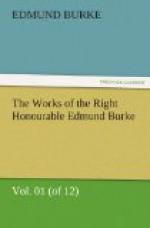“Dark with excessive light thy skirts appear.”
Here is an idea not only poetical in a high degree, but strictly and philosophically just. Extreme light, by overcoming the organs of sight, obliterates all objects, so as in its effect exactly to resemble darkness. After looking for some time at the sun, two black spots, the impression which it leaves, seem to dance before our eyes. Thus are two ideas as opposite as can be imagined reconciled in the extremes of both; and both, in spite of their opposite nature, brought to concur in producing the sublime. And this is not the only instance wherein the opposite extremes operate equally in favor of the sublime, which in all things abhors mediocrity.
SECTION XV.
LIGHT IN BUILDING.
As the management of light is a matter of importance in architecture, it is worth inquiring, how far this remark is applicable to building. I think, then, that all edifices calculated to produce an idea of the sublime, ought rather to be dark and gloomy, and this for two reasons; the first is, that darkness itself on other occasions is known by experience to have a greater effect on the passions than light. The second is, that to make an object very striking, we should make it as different as possible from the objects with which we have been immediately conversant; when therefore you enter a building, you cannot pass into a greater light than you had in the open air; to go into one some few degrees less luminous, can make only a trifling change; but to make the transition thoroughly striking, you ought to pass from the greatest light, to as much darkness as is consistent with the uses of architecture. At night the contrary rule will hold, but for the very same reason; and the more highly a room is then illuminated, the grander will the passion be.
SECTION XVI.
COLOR CONSIDERED AS PRODUCTIVE OF THE SUBLIME.
Among colors, such as are soft or cheerful (except perhaps a strong red, which is cheerful) are unfit to produce grand images. An immense mountain covered with a shining green turf, is nothing, in this respect, to one dark and gloomy; the cloudy sky is more grand than the blue; and night more sublime and solemn than day. Therefore in historical painting, a gay or gaudy drapery can never have a happy effect: and in buildings, when the highest degree of the sublime is intended, the materials and ornaments ought neither to be white, nor green, nor yellow, nor blue, nor of a pale red, nor violet, nor spotted, but of sad and fuscous colors, as black, or brown, or deep purple, and the like. Much of gilding, mosaics, painting, or statues, contribute but little to the sublime. This rule need not be put in practice, except where an uniform degree of the most striking sublimity is to be produced, and that in every particular; for it ought to be observed, that this melancholy kind of greatness, though it be certainly the highest, ought not to be studied in all sorts of edifices, where yet grandeur must be studied; in such cases the sublimity must be drawn from the other sources; with a strict caution however against anything light and riant; as nothing so effectually deadens the whole taste of the sublime.




